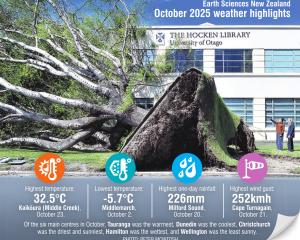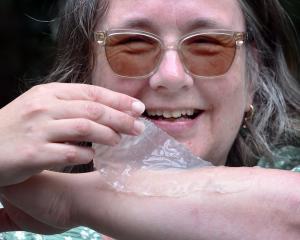It was 1862 when the Township of Roslyn was first subdivided and much has changed in the 147 years since.
Reporter Sarah Harvey finds that coffee, cake and crayfish are more common in the suburb these days than cable cars.
Roslyn, Dunedin, has in the past been synonymous with cable cars, with hilltop houses, with nearby private schools, and more recently with residents more than willing to join forces to protect their area.
The suburb on the crest of a hill, about 150m above sea level, catches the wind, but also the sun.
And, in the past couple of years it has also caught the interest of a wider group of users as it undergoes something of a renaissance as a dining and shopping hot spot, away from central Dunedin.
The sight of cable cars making their way through Roslyn, grocery stores displaying their wares and residents walking to the local shop is no longer common, but restaurants, cafes and designer clothing stores are.
Two restaurants, two cafes and a takeaway store, as well as the Friday Shop, now cater to the suburb's appetitites.
The newest addition, Luna, has added a new dimension to the area, with its commanding view of the city from the hilltop.
There is also a women's clothes store, a baby store, a florist, two supermarkets, a physiotherapist, doctors' rooms, pharmacy, hairdresser, day spa, real estate agents and a book and toy store in the village - and only about 4000 people who live in Roslyn.
Roslyn, in its changing form, does not face any major challenges, with the most pressing being the problem of parking and the road configuration.
However, residents continue to wage battles over developments in the area.
The most recent is an Environment Court appeal against a resource consent decision to allow a restaurant, cafe and bar in the former Roslyn fire station.
RM Designs was granted consent for the development in December last year. But City Rd resident Brent George has raised concerns about parking, privacy and noise.
The original application attracted 27 submissions, 13 of which opposed the development, and is the second for the fire station which has raised the ire of residents, after Erban Spa applied to move across the road into it.
The fire station is outside the local activity zone, which means it must provide parking. Other developments in the area have been within the zone and therefore do not have to provide parking.
In the case of the residents v Ryman Healthcare, the residents won.
The plan was to build a rest-home and dementia care unit on a site between Highgate and Tyne St. The Roslyn Residents Action Committee held meetings and lobbied against the project.
Probably the most hotly contested development was that of the Fresh Choice Supermarket which caused a storm of protest from 2002.
Some residents, who fought bitterly against upheavals in traffic, noise and a bright blue facade, still refuse to go to the supermarket.
National Party List MP Michael Woodhouse, of Dunedin, said the residents of the suburb of Roslyn were a "very active community".
"They are organised and have networks and community groups. They tend to galvanise themselves against projects which they feel may disrupt the community."
Roslyn's population is slightly older than the Otago average, with 14.6% of people in Roslyn south aged 65 years and over, at the 2006 census.
There are also slightly more aged under 15, as well.
By far the biggest ethnic group is European, but then so is the rest of Otago, with 81.7% of those in Roslyn south calling themselves Europeans and 77.5% in Roslyn north.
The unemployment rate in both Roslyn north and south is lower than that in Otago, with 2.9% and 3.1% respectively.
The most common occupation group is professionals, the same as in Otago. The next biggest occupation group is managers.
The median income in the suburb, about $29,000, is almost $8000 more than the median for Otago.
Mr Woodhouse said he believed Roslyn Village was undergoing a renaissance as a shopping precinct outside the central hub of the city. He believed the cafe and restaurant scene would continue to grow in Roslyn.
Former Dunedin City mayor and present councillor Richard Walls has lived in Maori Hill for 32 years, and has vivid memories of the old Roslyn.
"My earliest memories are of the cable car. Every Saturday morning we would jump on the cable car at Andersons Bay and then end up in Roslyn."
The biggest change was when the cable cars stopped, the hill was cut away to make way for the bridge, and motor vehicles took over Roslyn.
The key now was to not destroy its "unique critical configuration" which made it a hub and so popular with Dunedin residents.
"It definitely has become a little mecca where people can go for dining."
He believed Roslyn was taking on a new role as a destination, rather than a service village for suburb residents.
"Something quite unique is evolving," he said.
Historic Roslyn
1862 - James Kilgour, who had come to New Zealand in 1853, subdivided his property creating the Township of Roslyn. There were 56 sections most of which were about a quarter of an acre.
The sections sold from about £115.
1877 - Roslyn borough formed following the Municipal Corporations Act. James Kilgour was elected as mayor.
1878 - The population of Roslyn borough was 1565.
1881, February 6 - Roslyn cable car line opened. It was the first Hallidie-type cable car line to be constructed outside the United States.
1901 - Electric cable cars carried passengers from Roslyn along Highgate to Maori Hill.
1906 - The Falcon St section of the cable car was condemned as dangerous, so a new track was built to Kaikorai Valley.
1912 - Roslyn borough amalgamated with Dunedin city.
1951 - Excavations made to allow the present bridge to be installed linking Albert St with Highgate. What is now Stuart St was dug out so that it would go under the bridge and drop towards the city.
1951, October 26 - The Roslyn line was replaced with buses.
The naming of Roslyn
It is likely the name for the suburb came from the town of Roslin (also known as Rosslyn) in Lothian, south of Edinburgh.
It is also likely that James Kilgour who subdivided the suburb used his wife's maiden name, Ross, in naming the suburb.
It seems that Mr Kilgour had called his house and property Roslyn before he subdivided it.
The first written reference to Roslyn is in the township plan of 1862.
However, it has been suggested that the signwriter made a spelling mistake or that it was a cost-cutting measure to use one "s" instead of two.
Photos by Craig Baxter; prints available from Otago Images.














